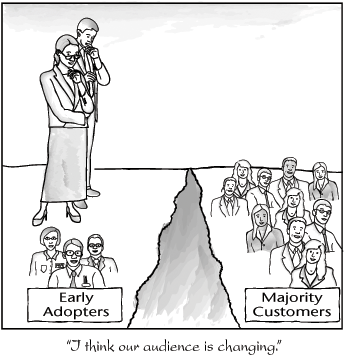Chapter 5. Understanding the Technology Adoption Life Cycle

Innovators will “. . . forgive ghastly documentation, horrendously slow performance, ludicrous omissions in functionality, and bizarrely obtuse methods of invoking some needed function—all in the name of moving technology forward.” Conservatives in the mature market want “. . . the gradual incorporation into the product of all the little aids that people develop, often on their own, to help them cope with its limitations”. | ||
| --Geoffrey A. Moore | ||
In his 1991 book, Crossing the Chasm, Geoffrey A. Moore outlines the stages of the technology adoption life cycle as it applies to high-tech products. Using the life-cycle model originated by Everett M. Rogers in his work, Diffusion of Innovations (Free Press 1995), Moore demonstrates how customers change significantly through the life of a successful high-tech product.
Rogers demonstrated that customers for new, innovative products can be arranged on a standard bell curve, as shown in Figure 5-1. The earliest to become interested in a new idea are called innovators, representing only 2.5% of the potential customers. If a new product succeeds in meeting the needs of the small number of innovators, it may be embraced by the early adopters. Only later will more conservative customers in the early and late majority accept a new product, although they represent a significant part of the ...
Get Information Development: Managing Your Documentation Projects, Portfolio, and People now with the O’Reilly learning platform.
O’Reilly members experience books, live events, courses curated by job role, and more from O’Reilly and nearly 200 top publishers.

